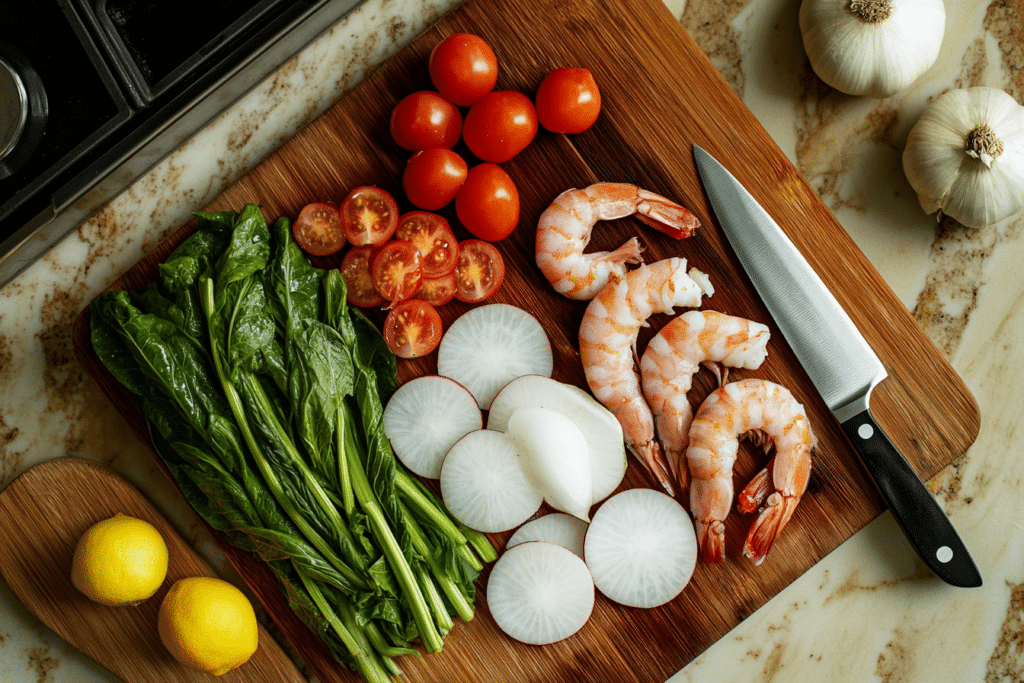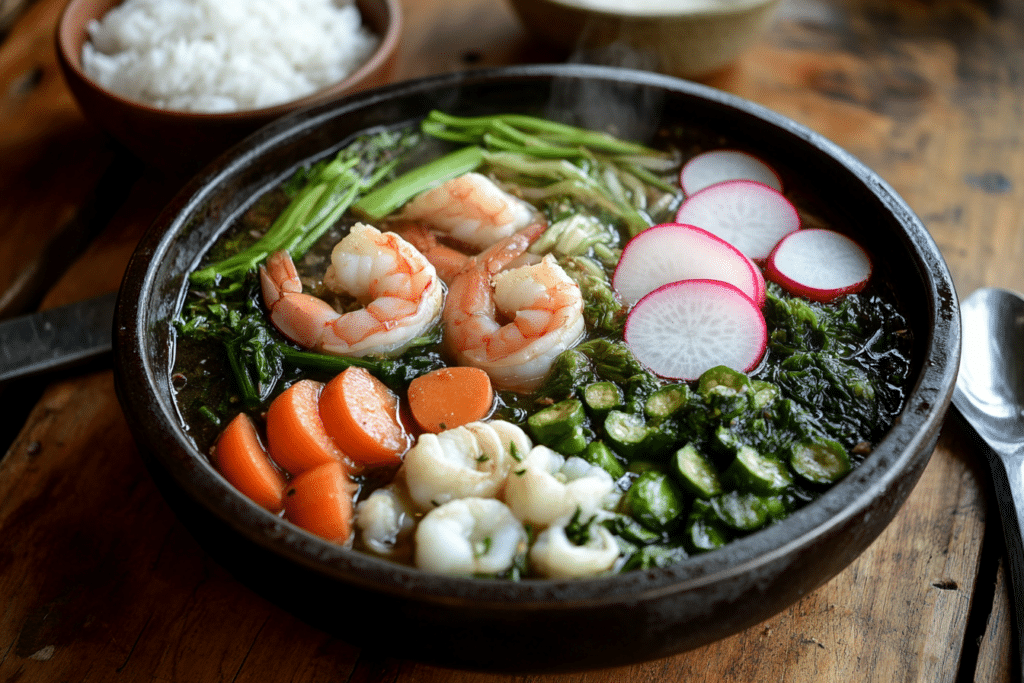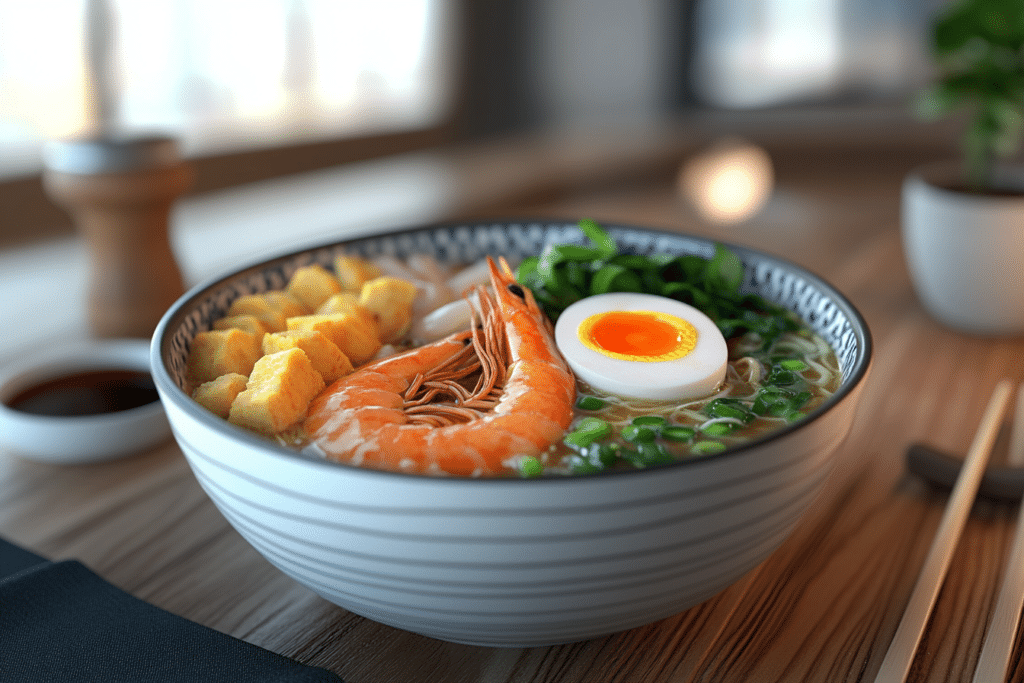1. Introduction
Sinigang is a traditional Filipino soup that captivates taste buds with its iconic sourness and savory flavors. This guide explores everything you need to know about the sinigang recipe, from classic versions to modern twists, ensuring you can recreate this comforting dish in your own kitchen.
Whether you prefer it with pork, shrimp, or fish, sinigang boasts a medley of fresh vegetables, protein, and tamarind as its star ingredient. This article will guide you through its origins, ingredients, preparation methods, and even creative twists for modern tastes.
2. What is Sinigang?
2.1. What Makes Sinigang Recipe a Filipino Classic?
Sinigang is a Filipino soup or stew characterized by its signature sourness, primarily derived from tamarind (sampalok). It is often regarded as a comfort food, enjoyed during family gatherings and as a remedy for cold weather or homesickness.
- Cultural Importance: Sinigang reflects Filipino ingenuity in utilizing local ingredients to create a hearty and flavorful dish. It’s a symbol of togetherness, as the dish is often cooked and shared with loved ones.
- Traditional Occasions: From Sunday lunches to special celebrations, sinigang holds a special place in Filipino homes.
2.2. Unique Flavor Profile of Sinigang Recipe
Sinigang’s flavor is a harmonious blend of sour and savory, making it stand out among other soups:
- Sourness: Tamarind serves as the key souring agent, providing a tangy kick.
- Savory Depth: The protein, whether pork, shrimp, or fish, enhances the soup’s umami flavor.
- Freshness: Vegetables like kangkong (water spinach), radish, and tomatoes add layers of flavor and texture.
This balance of flavors is what makes sinigang a favorite comfort dish.
2.3. Nutritional Benefits of Sinigang Recipe Ingredients
Sinigang’s combination of fresh vegetables and lean proteins makes it highly nutritious. To discover other tips for maintaining texture and flavor, visit our Secret to Soft Chewy Cookies:
- Rich in Vitamins: Vegetables like kangkong, radish, and tomatoes provide essential vitamins and minerals.
- Protein-Packed: Depending on the protein used, sinigang can be an excellent source of lean protein.
- Digestive Benefits: Tamarind is known for its digestive properties and high antioxidant content.
Tamarind is not just a key flavor in sinigang but also offers numerous health benefits, such as aiding digestion and providing antioxidants. Learn more about the nutritional benefits of tamarind at Healthline: Nutritional Benefits of Tamarind.
3. Essential Ingredients for the Perfect Sinigang Recipe

3.1. Best Proteins for a Sinigang Recipe
Sinigang’s versatility shines through the variety of proteins that can be used as its base. Each protein lends a distinct character to the dish:
- Pork: The most common choice, typically pork belly (liempo) or pork ribs for their rich flavor and tender texture.
- Shrimp: Ideal for a lighter, seafood-forward sinigang.
- Fish: Milkfish (bangus) is a popular option, offering a delicate and mildly sweet taste.
- Beef: Used less frequently but provides a hearty, robust flavor.
Choosing the right protein allows you to tailor the dish to your taste preferences.
3.2. Essential Vegetables for Sinigang Recipe
The vibrant medley of vegetables in sinigang adds both flavor and nutrition:
- Kangkong (Water Spinach): Adds freshness and a slightly earthy flavor.
- Radish: Provides a mild peppery taste and a crunchy texture.
- Eggplant: Absorbs the tangy broth beautifully, adding depth.
- Okra: Thickens the broth slightly and enhances its consistency.
- Tomatoes: Serve as a natural souring agent and add a subtle sweetness.
These vegetables contribute to the dish’s vibrant and wholesome appeal.
3.3. Tamarind: The Star of a Sinigang Recipe
Tamarind (sampalok) is the defining ingredient in sinigang, responsible for its iconic sourness.
- Fresh Tamarind: Provides the most authentic flavor but requires preparation.
- Tamarind Paste or Mix: Convenient alternatives that still deliver excellent results.
- Alternative Souring Agents: If tamarind is unavailable, ingredients like calamansi, green mangoes, or tomatoes can be used as substitutes.
The sourness level can be adjusted to suit individual preferences, making the dish highly customizable.
4. Classic Sinigang Recipe Variations
4.1. Sinigang na Hipon (Shrimp Sinigang)
Shrimp sinigang, or sinigang na hipon, is a popular seafood variation known for its light and refreshing flavors.

Ingredients:
- 500g shrimp, cleaned and deveined
- 1 liter water
- 2 medium tomatoes, quartered
- 1 medium onion, sliced
- 1 cup tamarind mix or 1/4 cup fresh tamarind pulp
- 1 radish, sliced into thin rounds
- 6 pieces okra, trimmed
- 1 cup kangkong (water spinach)
- Salt and pepper to taste
Instructions:
- Boil the Base: In a pot, bring water to a boil. Add the onions and tomatoes, simmering until softened.
- Add Tamarind: Stir in the tamarind mix or fresh tamarind pulp until dissolved. Adjust sourness to taste.
- Cook the Vegetables: Add radish and okra, cooking until tender.
- Cook the Shrimp: Add the shrimp and let them cook for 3–5 minutes, or until they turn pink.
- Finish with Greens: Add kangkong leaves, stir, and turn off the heat.
Serve hot with steamed rice for a light yet flavorful meal.
4.2. Sinigang na Bangus (Milkfish Sinigang)
This variation highlights the delicate and mildly sweet flavor of milkfish (bangus), a favorite in Filipino cuisine.
Ingredients:
- 1 medium-sized milkfish, cleaned and sliced into steaks
- 1 liter water
- 2 medium tomatoes, quartered
- 1 medium onion, sliced
- 1 cup tamarind mix or 1/4 cup fresh tamarind pulp
- 1 eggplant, sliced into rounds
- 6 string beans, cut into 2-inch lengths
- 1 cup kangkong (water spinach)
- Salt and fish sauce to taste
Instructions:
- Prepare the Broth: In a pot, boil water with onions and tomatoes until the tomatoes soften.
- Add Tamarind: Mix in the tamarind paste or pulp, adjusting the sourness to your preference.
- Cook Vegetables: Add eggplant and string beans, simmering until tender.
- Add the Fish: Gently place the milkfish pieces into the pot and cook for 8–10 minutes, or until the fish is cooked through.
- Finish with Greens: Add kangkong leaves and turn off the heat.
This variation is perfect for those seeking a lighter, fish-based sinigang.
5. Regional Sinigang Recipe Variations
5.1. Sinigang Recipe with Miso
Sinigang sa miso is a regional favorite that incorporates miso paste to add richness and depth to the broth.
Key Features:
- Miso Paste: A fermented soybean paste that enhances the umami flavor of the dish.
- Best Protein Pairing: Commonly paired with fish such as bangus (milkfish) or tuna.
Preparation Tip:
Dissolve the miso paste in the broth after boiling the base to ensure it blends evenly with the sour tamarind flavor.
5.2. Sinampalukang Manok (Chicken Sinigang)
This variation uses chicken as the protein and young tamarind leaves (sampaloc leaves) as the souring agent.
Key Features:
- Distinctive Sourness: The young tamarind leaves provide a fresh, tangy flavor that’s slightly less intense than tamarind pulp.
- Aromatic Base: Often cooked with ginger for a fragrant and warming broth.
Serving Tip:
Serve with steamed rice and a side of soy sauce with calamansi for dipping.
5.3. Regional Additions
Certain regions in the Philippines incorporate unique ingredients into their sinigang to reflect local flavors:
- Green Mangoes: Used as a souring agent in some Visayan provinces.
- Batuan Fruit: A regional ingredient in the Western Visayas, known for its distinct tangy flavor.
- Guava (Bayabas): Adds a mild sweetness to the broth and is popular in Luzon.
The addition of green mangoes, batuan fruit, or guava showcases the regional creativity of Filipino sinigang recipes. Discover more about Filipino regional recipes at Serious Eats: Filipino Regional Recipes.
6. Tips and Tricks for Perfecting Sinigang
6.1. Balancing the Sourness and Savory Taste
One of the key aspects of sinigang is achieving the perfect balance between its sour and savory flavors. Here’s how:
- Adjust the Tamarind: Add tamarind pulp or mix gradually to control the level of sourness.
- Season Well: Use fish sauce (patis) or salt to enhance the umami taste.
- Add Tomatoes: Include more tomatoes for a natural sweetness that counterbalances the sourness.
Pro Tip: Taste the broth at every stage of cooking and adjust seasonings accordingly.
6.2. Achieving the Perfect Broth Consistency
A well-made sinigang broth is neither too watery nor overly thick. Here’s how to get it just right:
- Simmer Slowly: Allow the ingredients to simmer gently to extract maximum flavor.
- Mash the Tomatoes: For a slightly thicker and more flavorful broth, mash the softened tomatoes into the soup.
- Use Fresh Ingredients: Fresh vegetables and proteins enhance the overall quality of the broth.
Pro Tip: Avoid boiling the soup vigorously, as this can make the broth cloudy and overly harsh. A rich and flavorful broth is essential to sinigang. Learn techniques to achieve the perfect broth by simmering ingredients gently at Epicurious: Cooking Tips for Perfect Broths.
6.3. Enhancing with Modern Twists
Modern variations of sinigang can incorporate unique ingredients without losing its authentic charm:
- Tofu or Mushrooms: Great for a vegetarian twist.
- Truffle Oil: Adds a luxurious touch to the dish.
- Seaweed: Enhances the umami flavor in seafood-based sinigang.
These enhancements offer exciting ways to enjoy sinigang while keeping it relevant to contemporary tastes.
7. Creative Twists on the Sinigang Recipe
7.1. Sinigang Fried Rice
Sinigang fried rice offers a new way to enjoy its tangy flavors. For more creative recipes, check out our Brookie Recipe: Perfect Brownie Cookie Bars.
Ingredients:
- 3 cups cooked rice
- 1 cup leftover sinigang broth
- 1 cup shredded protein (shrimp, fish, or chicken)
- ½ cup diced vegetables (okra, radish, or kangkong stems)
- 1 tablespoon fish sauce (optional)
Instructions:
- Heat a large pan or wok and sauté the diced vegetables.
- Add the shredded protein and leftover broth, cooking until slightly reduced.
- Stir in the cooked rice, mixing well to coat evenly with the tangy broth.
- Adjust seasoning with fish sauce or salt as needed.
This dish transforms sinigang into a savory, tangy fried rice perfect for a second meal.
7.2. Sinigang Ramen
A fusion of Filipino and Japanese cuisines, sinigang ramen combines the sourness of sinigang with the comforting warmth of ramen.

Ingredients:
- 1 liter sinigang broth
- 2 packs fresh ramen noodles
- 1 cup cooked shrimp or pork slices
- 1 boiled egg, halved
- Sliced scallions for garnish
Instructions:
- Prepare the sinigang broth as usual.
- Cook the ramen noodles separately according to package instructions.
- Assemble the ramen bowl by placing noodles, protein, and boiled egg in a bowl.
- Pour the hot sinigang broth over the ingredients and garnish with scallions.
This dish is ideal for ramen lovers seeking a Filipino twist.
7.3. Vegan Sinigang
For those on a plant-based diet, vegan sinigang offers all the classic flavors without animal products.
Ingredients:
- 1 liter water
- 1 cup tamarind mix or fresh tamarind pulp
- 1 cup tofu cubes, pan-fried
- 1 cup mushrooms (shiitake or button)
- Assorted vegetables (radish, kangkong, okra, tomatoes)
Instructions:
- Boil water with tomatoes and onions until softened.
- Add tamarind and adjust sourness to taste.
- Cook the vegetables until tender, then stir in the pan-fried tofu and mushrooms.
This variation retains the essence of sinigang while being completely vegan.
8. Frequently Asked Questions (FAQs)
8.1. What Is Sinigang Made Of?
Sinigang is made of a sour broth base, typically flavored with tamarind, and a combination of protein and vegetables. The common ingredients include:
- Protein: Shrimp, fish, pork, or chicken.
- Vegetables: Kangkong (water spinach), radish, okra, tomatoes, and eggplant.
- Seasonings: Tamarind as the souring agent, fish sauce, and salt.
8.2. Is Filipino Sinigang Healthy?
Yes, sinigang is considered a healthy meal due to its nutritious vegetables and lean protein. Learn about other health-friendly recipes in our Ninja Creami Recipes Guide :
- Rich in Vitamins: Vegetables like kangkong and radish provide essential nutrients.
- Low in Calories: The broth-based soup is generally low in calories compared to cream-based dishes.
- Good Source of Protein: Depending on the protein choice, sinigang can be a lean, high-protein meal.
8.3. How to Cook Sinigang Step by Step?
Cooking sinigang involves the following steps:
- Prepare the Base: Boil water with tomatoes and onions to build flavor.
- Add the Tamarind: Stir in tamarind mix or fresh tamarind pulp to achieve the desired sourness.
- Cook the Protein: Add your chosen protein (shrimp, fish, or chicken) and simmer until cooked.
- Add Vegetables: Incorporate vegetables like radish, okra, and kangkong, cooking until tender.
- Season: Adjust the taste with fish sauce or salt before serving.
8.4. What Ingredients of Sinigang Are Mentioned in the Selection?
The key ingredients typically mentioned in sinigang recipes include tamarind, tomatoes, onion, radish, kangkong, and a chosen protein like shrimp or fish. These ingredients are essential to achieving the classic sour and savory flavor profile.
9. Conclusion
Sinigang is more than just a dish; it is a heartfelt representation of Filipino culture and culinary ingenuity. Its perfect balance of sourness and savory flavors, coupled with the freshness of local ingredients, makes it a favorite among Filipinos and food enthusiasts worldwide.
Whether you prefer the classic shrimp or fish versions or enjoy experimenting with creative twists like sinigang fried rice or ramen, this dish’s versatility ensures there’s something for everyone. Beyond its delicious taste, sinigang’s nutritional benefits make it a wholesome and satisfying meal.
Now it’s your turn to bring the flavors of sinigang into your kitchen. Explore its rich history, play with regional variations, or create your unique version. Whatever you choose, one thing is certain—sinigang is a dish that will always bring warmth, comfort, and joy to the table.
